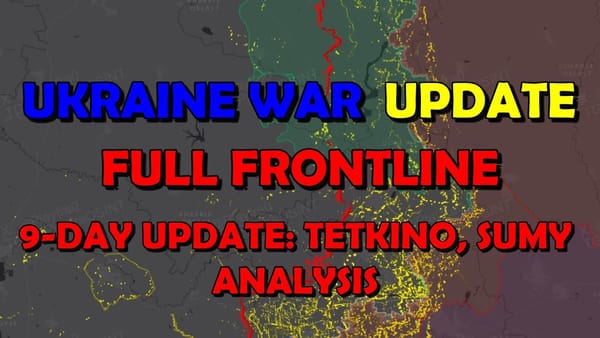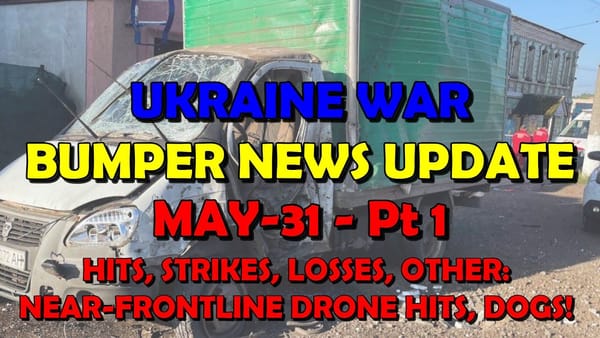Ukraine Conflict: Full Frontline Update
Table of Contents 📖
"Second greatest army in the world, one and a half years to take Bakhmut. Literally, that's it. Second greatest army in the world, one and a half years to take Bakhmut. One and a half years to take Bakhmut. Again, I keep saying it is embarrassing."
Hello Team
🎦 00:00-00:20⏩
Jonathan welcomes viewers to another video - a Ukraine War Frontline Update for 1st February 2024. Viewers unfamiliar with the symbols on the map are advised to pause the video to check the key.
Return to top⤴️
📍 FRONT-LINE UPDATE -🗺️ MAP LEGEND

Ukrainian Naval Successes
🎦 00:20-01:48⏩
Jonathan begins by noting positive developments for Ukraine:
- The EU has unanimously approved €50 billion in military aid.
- €4.5 billion of this aid is expected to reach Ukraine in March.
- A Russian ship (the Ivanovets corvette) has been sunk. Jonathan analyses footage of the attack, speculating that Ukrainian USVs entered the Kerch Straight before entering a lake to attack the ship in an inland inlet. He praises the Ukrainians' clever use of the drones.
Kupyansk and Lyman-Kreminna Front Line
🎦 01:48-05:26⏩
Turning to the frontline, Jonathan analyses the fighting along the Kupyansk and Lyman-Kreminna axes, noting that the situation represents a mixed bag for Ukraine:
- He acknowledges claims by pro-Russian mapper Srep Maps that Russian forces have increased attacks west of Synkivka, forcing Ukrainian troops to retreat towards the Oskil River.
- He also notes that other mappers, particularly Syriac Maps, have consistently shown Ukrainian losses in the area.
- However, he emphasises that these claims should be treated with caution, as there is often a lack of clarity regarding the exact situation on the ground.
- Moving south to the Terny sector, Jonathan observes that two mappers, DeepStateMap and Suriyat Maps, agree that Russian troops have advanced significantly towards Torske, potentially by as much as 1.4km. This advance is noteworthy, he suggests, as it brings Russian forces closer to Yampolivka and Torske.
- Throughput Map supports these claims, reporting that Russian forces have advanced 2.1-2.3km from Torske over the past three days.
- However, the ISW's latest assessment, based on data from the previous night, only reports positional fighting in the area with no confirmed changes. Jonathan says he will continue to monitor the situation.
- Further south still, around Zarichne, DeepStateMap and Suriyat Maps indicate minor Ukrainian losses. Again, Jonathan urges caution in interpreting these changes, as they may reflect adjustments based on new footage rather than actual battlefield losses. He concludes that the situation in this sector remains fluid, with both sides engaging in push-and-pull manoeuvres. However, he expresses concern that Ukrainian forces may have lost ground in the Russian advance toward Torske.
Bakhmut Front Line
🎦 05:26-08:52⏩
Jonathan then focuses on the Bakhmut front, highlighting Ukrainian gains near Bohdanivka for the second consecutive day. This is encouraging news, he believes, as it allows Ukrainian forces to establish a buffer zone around Chasiv Yar, a strategically important location that could potentially become the "second Bakhmut".
- He provides historical context for the fighting in the area, noting the prolonged Russian offensive to capture Bakhmut and the challenges Ukrainian forces faced, including ammunition shortages and communication problems that led to the loss of Soledar.
- Looking ahead, he emphasises the importance of Chasiv Yar's defences, describing it as "arguably better defended" than Bakhmut due to its topography (hills, marshes, forests) and the Ukrainian military's preparations.
- Examining the terrain, he explains that Ukrainian control of the high ground near Bohdanivka offers them a tactical advantage, providing a good field of view over Russian positions.
- Moving south to the Kurdiumivka area, near the canal, Suriyat Maps shows possible Ukrainian gains. However, Jonathan again advises caution in interpreting these changes, as they may simply reflect a redrawing of the map based on new information rather than actual Ukrainian advances. He points out that Andrew Perpetua, a reliable source, has not indicated any Russian presence north or northwest of Kurdiumivka, suggesting that the situation there may be different from what Suriyat Maps depicts. Despite the uncertainty, he welcomes the presence of blue pins (representing Ukrainian gains) on the map.
Avdiivka Front Line
🎦 08:52-18:40⏩
Shifting his attention to Avdiivka, Jonathan analyses the complex situation in the southern part of the city:
- He begins by noting a single pin on Suriyat Maps near the Salska/Hota area, marking a location where Russian forces reportedly tunnelled under a restaurant using water and sewage pipes. He questions the extent of Russian control in the area, highlighting discrepancies between different mappers' assessments. He criticises Suriyat Maps' tendency to assume Russian control based solely on the presence of Russian personnel or vehicles, even in situations where control is uncertain.
- Turning to the ISW's analysis, Jonathan notes their assessment that Russian forces made marginal advances along Sportivna Street in southern Avdiivka on January 31st. However, the report also acknowledges that Russian forces sustained significant losses (about a company's worth of heavy armoured vehicles) during assaults in the area.
- Jonathan then cross-references the ISW's assessment with claims from a Russian milblogger who asserted that Russian forces advanced up to 500m wide and 300m deep along Chernyshevskogo, Sportivna, and Saborna Streets.
- Analysing these claims on the map, Jonathan expresses scepticism about Suriyat Maps' depiction of the situation, given the reported Russian losses.
- He cites footage of a Ukrainian tank firing on Russian positions on Sportivna Street, suggesting that the area may be contested rather than under firm Russian control.
- He also references information from Andrew Perpetua, who described the area as a "grey zone" due to the presence of Ukrainian tanks clearing it out. This information, combined with the reported Russian losses, leads Jonathan to conclude that Suriyat Maps' portrayal of Russian control in the area is likely inaccurate.
- Further south, near Mariinka and Novomykhailivka, Jonathan observes Russian gains indicated by Suriyat Maps and DeepStateMap. However, he again urges caution in interpreting these changes, citing information from the ISW and geolocated footage that contradict Suriyat Maps' assessment.
- The ISW reports confirmed Russian advances southwest of Donetsk on January 30th, including west of Solodka, but also highlights significant Russian armoured vehicle losses during those assaults.
- Geolocated footage analysed by Twitter user "Ocean" corroborates these losses, showing the destruction of numerous Russian vehicles, potentially an entire convoy, in the area. Jonathan expresses doubt about Russian control over the area, given the scale of their losses, and criticises Suriyat Maps' methodology, which equates the presence of Russian vehicles with control, even when those vehicles are subsequently destroyed.
- He concludes that while Russian forces may have made some advances in the area, the situation remains fluid and Suriyat Maps' portrayal of Russian control is likely exaggerated.
Velyka Novosilka - Huliaipole Front Line
🎦 18:40-19:11⏩
Moving west to the Velyka Novosilka sector, Jonathan bypasses Velyka Novosilka itself and focuses on Robotyne, where Andriy Perpetua reports Ukrainian gains northwest of Verbove.
- He expresses satisfaction with these gains, noting that they demonstrate Ukrainian forces' ability to push back against Russian pressure and maintain their fighting spirit despite challenges related to ammunition and troop levels.
- He also highlights ongoing fighting west of Robotyne, suggesting that the situation in this sector remains dynamic.
Southern Front Line
🎦 19:11-22:50⏩
Finally, Jonathan examines the southern front line, specifically the situation around Krynky:
- He acknowledges a report, translated by WarTranslated, suggesting that Ukrainian forces may have established a new foothold in Krynky, potentially along the Konka River. However, he emphasizes that this report is based on a single, unconfirmed Russian source and therefore should be treated with extreme caution.
- Despite the lack of corroboration, he acknowledges that enemy attestations (admissions by the opposing side) often carry more weight, as they can be embarrassing and therefore less likely to be fabricated.
- He then turns to the ISW's analysis of the area, which reports continued positional engagements on the east bank of the Dnipro River near Krynky.
- The ISW cites Ukrainian Southern Operational Command spokesperson Natalia Humeniuk, who stated that Russian forces have intensified infantry assaults on the east bank but sustained heavy casualties (up to 70%).
- Jonathan questions the accuracy of the 70% casualty figure but acknowledges that even if exaggerated, it still suggests significant Russian losses. Humeniuk also reported increased Russian use of FPV drones (up to 70 per day) but noted that Ukrainian forces are effectively countering them with small arms fire and electronic warfare systems, regularly downing about half of them.
- The ISW further reports that elements of the Russian 337th Airborne Regiment (VDV) are operating in the area. Jonathan expresses scepticism about the "elite" designation of Russian units, noting that the prolonged fighting has likely degraded the capabilities of both sides' forces.
Putin's War Aims
🎦 22:50-34:00⏩
In the second part of the video, Jonathan analyses Putin's stated war aims, which he deems unrealistic and unattainable:
- He argues that Putin's goal of pushing the frontline back to create a "demilitarised" or "sanitary" zone protecting Russian-controlled territory (including occupied Ukrainian land) from Ukrainian artillery and Western-provided long-range systems is inherently flawed.
- Jonathan points out that any Ukrainian territory captured by Russia in pursuit of this goal would likely be annexed, as was the case with parts of four Ukrainian oblasts, making these newly claimed territories vulnerable to Ukrainian strikes.
- This paradox, he contends, creates a never-ending cycle where Russia would constantly need to seize more territory to protect its previous gains, ultimately requiring the occupation of all of Ukraine to achieve Putin's objective.
- He supports his argument by citing a Russian nationalist milblogger who, despite supporting the war, acknowledges that Russia would need to capture Mykolaiv and Odesa to protect occupied Crimea from Ukrainian long-range strikes and the Slovyansk-Kramatorsk line in Donetsk Oblast to alleviate pressure on the current frontline.
- Jonathan illustrates this dilemma using the map, demonstrating how Russia's territorial ambitions would constantly bring new areas within range of Ukrainian weapons systems, making Putin's goal of a secure "buffer zone" impossible to achieve as long as an independent Ukraine exists.
- He criticizes Putin's aims as delusional and out of touch with the reality on the ground, citing the slow pace of Russian advances and the heavy losses they have sustained.
- He questions how Russia could realistically hope to conquer and hold vast swathes of Ukrainian territory when it took them over a year to capture the relatively small city of Bakhmut.
- Jonathan also highlights the inconsistency between Putin's stated objectives and his recent claim that Russian forces had made significant gains near Avdiivka, capturing 19 houses.
- He argues that this claim, even if true, pales in comparison to the scale of Russia's overall ambitions and is likely intended for domestic propaganda purposes rather than reflecting a genuine shift in the military situation.
- Jonathan concludes by reiterating his belief that Putin's war aims are unattainable and that the Russian leadership is either delusional or deliberately misleading the Russian public about the war's objectives and likely outcome.
Wrap up
🎦 34:00-34:10⏩
Jonathan thanks viewers for watching and encourages them to like, subscribe, and share the video.
Return to top⤴️



